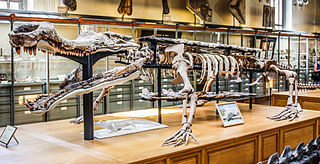
Sarcosuchus is an extinct genus of crocodyliform and distant relative of living crocodilians that lived during the Early Cretaceous, from the late Hauterivian to the early Albian, 133 to 95 million years ago of what is now Africa and South America. It was one of the largest crocodile-line reptiles, reaching an average estimate of 9 m (30 ft) and 3.5 metric tons, but estimated to grow up to 9.5 m (31 ft) in body length and weigh up to 4.3 metric tons. It is known from two species, S. imperator from the early Albian Elrhaz Formation of Niger and S. hartti from the Late Hauterivian of northeastern Brazil, other material is known from Morocco and Tunisia and possibly Libya and Mali.

Euoplocephalus is a genus of very large, herbivorous ankylosaurid dinosaurs, living during the Late Cretaceous of Canada. It has only one named species, Euoplocephalus tutus.

Leptoceratops, is a genus of leptoceratopsid ceratopsian dinosaurs from the late Cretaceous Period of what is now Western North America. Their skulls have been found in Alberta, Canada and Wyoming.
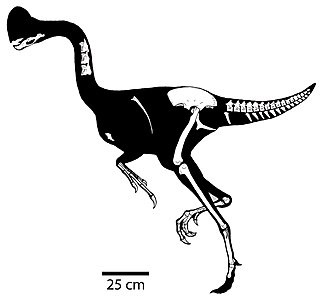
Chirostenotes is a genus of oviraptorosaurian dinosaur from the late Cretaceous of Alberta, Canada. The type species is Chirostenotes pergracilis.

Caenagnathus is a genus of caenagnathid oviraptorosaurian dinosaur from the late Cretaceous period. It is known from partial remains including lower jaws, a tail vertebra, hand bones, and hind limbs, all found in the Dinosaur Park Formation of Alberta, Canada. Caenagnathus weighed about a maximum of 96 kg (212 lb).

Allodaposuchus is an extinct genus of crocodyliforms that includes four species that lived in what is now southern Europe during the Campanian and Maastrichtian stages of the Late Cretaceous. Although generally classified as a non-crocodylian crocodylomorph, it is sometimes placed as one of the earliest true crocodylians. Allodaposuchus is one of the most common Late Cretaceous crocodylomorphs from Europe, with fossils known from Romania, Spain, and France.
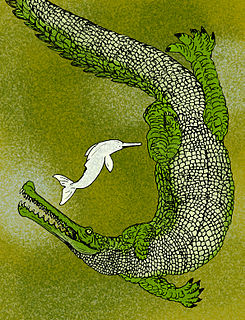
Rhamphosuchus is an extinct genus of gavialid crocodylians. It lived during the Miocene and its fossils have been found in two regions; the Siwalik Hills of Pakistan and India as well as the Sindh region of Pakistan. Its type species is Rhamphosuchus crassidens, which is only known from incomplete sets of fossils, mostly teeth and skulls. Four species traditionally placed in the genus Gavialis may be included as well.

Caenagnathidae is a family of bird-like maniraptoran theropod dinosaurs from the Cretaceous of North America and Asia. They are a member of the Oviraptorosauria, and close relatives of the Oviraptoridae. Like other oviraptorosaurs, caenagnathids had specialized beaks, long necks, and short tails, and would have been covered in feathers. The relationships of caenagnathids were long a puzzle. The family was originally named by Raymond Martin Sternberg in 1940 as a family of flightless birds. The discovery of skeletons of the related oviraptorids revealed that they were in fact non-avian theropods, and the discovery of more complete caenagnathid remains revealed that Chirostenotes pergracilis, originally named on the basis of a pair of hands, and Citipes elegans, originally thought to be an ornithomimid, named from a foot, were caenagnathids as well.

Borealosuchus is an extinct genus of crocodyliforms that lived from the Late Cretaceous to the Eocene in North America. It was named by Chris Brochu in 1997 for several species that had been assigned to Leidyosuchus. The species assigned to it are: B. sternbergii, the type species, from the Maastrichtian of Colorado, Montana, North Dakota, South Dakota, and Wyoming; B. acutidentatus, from the Paleocene of Saskatchewan; B. formidabilis, from the Paleocene of North Dakota; B. griffithi, from the Paleocene of Alberta; and B. wilsoni, from the Eocene of Wyoming. B. formidabilis is particularly well-known, represented by the remains of many individuals from the Wannagan Creek site in North Dakota.
Albertochampsa is an extinct genus of globidontan alligatoroid from the Late Cretaceous of Alberta. It was named in 1972 by Bruce Erickson, and the type species is A. langstoni. It is known from a skull from the Campanian-age Dinosaur Park Formation, where it was rare; Leidyosuchus is the most commonly found crocodilian at the Park. The skull of Albertochampsa was only about 21 cm long (8.3 in).
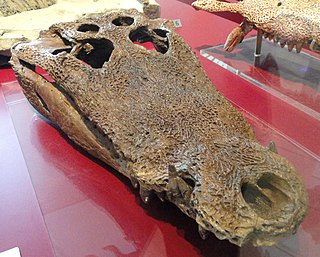
Leidyosuchus is an extinct genus of alligatoroid from the Late Cretaceous of Alberta. It was named in 1907 by Lawrence Lambe, and the type species is L. canadensis. It is known from a number of specimens from the middle Campanian age Dinosaur Park Formation. It was a medium-sized alligatorid, with a maximum skull length greater than 40 centimeters (16 in).

Harpacochampsa is a poorly known Early Miocene crocodilian from the Bullock Creek lagerstätte of the Northern Territory, Australia. The current specimen consists of a partial skull and fragments of a long slender snout reminiscent of that of a false gharial, demonstrating that it was a piscivore in life.

Asiatosuchus is an extinct genus of crocodyloid crocodilians that lived in Eurasia during the Paleogene. Many Paleogene crocodilians from Europe and Asia have been attributed to Asiatosuchus since the genus was named in 1940. These species have a generalized crocodilian morphology typified by flat, triangular skulls. The feature that traditionally united these species under the genus Asiatosuchus is a broad connection or symphysis between the two halves of the lower jaw. Recent studies of the evolutionary relationships of early crocodilians along with closer examinations of the morphology of fossil specimens suggest that only the first named species of Asiatosuchus, A. grangeri from the Eocene of Mongolia, belongs in the genus. Most species are now regarded as nomina dubia or "dubious names", meaning that their type specimens lack the unique anatomical features necessary to justify their classification as distinct species. Other species such as "A." germanicus and "A." depressifrons are still considered valid species, but they do not form an evolutionary grouping with A. grangeri that would warrant them being placed together in the genus Asiatosuchus.

Bergisuchus is an extinct genus of small sebecosuchian mesoeucrocodylian known primarily from the Eocene Messel Pit in Germany. Few fossils of Bergisuchus have been discovered, only a single incomplete snout, a few partial lower jaws and some teeth. Despite being fragmentary, the jaw bones are enough to indicate that Bergisuchus had a short, deep, narrow snout and serrated teeth, quite unlike the broad flat snouts of modern crocodylians.
Prodiplocynodon is an extinct genus of basal crocodyloid crocodylian. It is one of the only crocodyloids known from the Cretaceous and existed during the Maastrichtian stage. The only species of Prodiplocynodon is the type species P. langi from the Lance Formation of Wyoming, known only from a single holotype skull lacking the lower jaw.

Thecachampsa is an extinct genus of gavialoid crocodylian, traditionally regarded as a member of the subfamily Tomistominae. Fossils have been found from the eastern United States in deposits of Miocene age. Those named in the 19th century were distinguished primarily by the shape of their teeth, and have since been combined with T. antiquus. More recently erected species were reassigned from other genera, although their assignment to Thecachampsa has since been questioned.
Bauruoolithus is an oogenus of fossilized eggs belonging to an extinct crocodyliform from the Late Cretaceous of Brazil. Bauruoolithus eggs were most likely laid by the notosuchian crocodyliform Baurusuchus. Eggs of Bauruoolithus were described in 2011 from the Adamantina Formation. The type oospecies is B. fragilis.
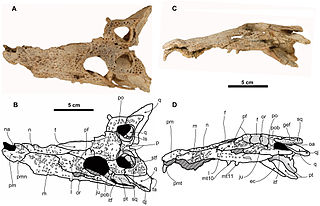
Arenysuchus is an extinct genus of crocodyloid from Late Cretaceous deposits of north Spain. It is known from the holotype MPZ ELI-1, a partial skull from Elías site, and from the referred material MPZ2010/948, MPZ2010/949, MPZ2010/950 and MPZ2010/951, four teeth from Blasi 2 site. It was found by the researchers José Manuel Gasca and Ainara Badiola from the Tremp Formation, in Arén of Huesca, Spain. It was first named by Eduardo Puértolas, José I. Canudo and Penélope Cruzado-Caballero in 2011 and the type species is Arenysuchus gascabadiolorum. The generic name refers to the finding site, and "suchus", from Greek meaning crocodile. The specific name honours the researchers who discovered the holotype.

Orientalosuchina is an extinct clade of alligatoroid crocodylians from South and East Asia that lived during the Paleocene and Eocene.
Jiangxisuchus is an extinct genus of crocodylian that lived during the Late Cretaceous in what is now China. It was described in 2019, and was proposed to be a basal member of Crocodyloidea. However, another concurrent 2019 study recovered Jiangxisuchus instead as a basal member of Alligatoroidea, within the newly named clade Orientalosuchina.


















